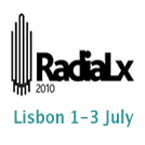Sounds of My Life
Sounds of My Life
Sounds of My Life is an experimental radio art narrative that combines,
layers, and remixes segments of oral history, audio narrative, soundscapes, found sounds,
samples of radio drama, appropriation, cut ups, and sound effects to create a meaningful
listening experience.
Exhibitions
 Future Places: Digital Media and Local
Culture
Future Places: Digital Media and Local
Culture
Invited broadcast, international, 28:08
Rádio Futura
Lisbon, Portugal
14-15 October 2010
Invited for broadcast as part of Future Places: Digital Media and Local Culture conference, a collaboration between the Science and Technology Foundation of Portugal and the University of Texas at Austin with a focus on interdisciplinary research, education, and capacity building in advanced digital media addressing the potential and impact of digital media on local culture. Renamed Analog Memories::Digital Futures to align with conference theme.
 RadiaLx 2010
International Festival of Radio Art
RadiaLx 2010
International Festival of Radio Art
Juried broadcast, international, 28:08
Rádio Zero
Lisbon, Portugal
1-3 July 2010
Titled Sounds of My Life to reflect the transmission art approach I took to
conceptualize this work.
Broadcast
schedule
Participants
RadiaLx convenes every two years, providing a forum for international artists and producers to explore and share "new and forgotten ways of making radio." Broadcast by Radio Zero at the Lisbon Institute of Technology, RadiaLx highlights radio not just as a broadcast medium, but as an active social enhancer focusing on participative and social awareness of the radio art form and technology. Broadcast by Rádio Zero, part of the international Radia network.
Background
I created and submitted Sounds of My Life for the RadiaLx 2010 International Festival of Radio Art, 1-3 July 2010. My work was accepted, and broadcast by by Radio Zero at the Lisbon Institute of Technology, and by other radio stations in the Radia international network. Sounds of My Life was invited for rebroadcast during the Future Places: Digital Media and Local Culture, also in Lisbon, Portugal, 14-15 October 2010.
Timeline and Content
Vancouver, Washington, Symphony Orchestra tuning
X Minus One blastoff SFX
The opening of the classic radio show, X Minus One, broadcast on NBC from 24
April 1955-9 January 1958. The rocket launch SFX was a backdrop to the narrator's
introduction of another tale of "new dimensions in time and space."
"Survivor" (excerpt 1)
Oral history
Oral histories are recording impressions, opinions, or experiences lived by the speaker,
generally in relation to some historic or otherwise significant event. "Survivor" (excerpt
1) is a recorded conversation with one survivor of the atomic bomb blast at Hiroshima. The
survivor speaks through a translator to recount her experiences.
"Is Everybody In?" (excerpt)
William Burroughs reading a poem by Jim Morrison, over a soundtrack provided by Morrison and
The Doors.
"Broadcasting in digital stereo . . ."
Broadcast stinger
Skills in digital audio production are often applied to more utilitarian pursuits. That does
not mean, however, that these efforts have to be any less creative. A truly wonderful piece
of audio draws no attention to itself, but immerses the listener in a cocoon of believable
and participatory reality.
Wilhelm scream
SFX
A frequently-used SFX for film and television, used in more than 216 films since 1951, and
now a popular cinematic clichè.
"Dance with Tweaks and Whistles"
Audio narrative
An audio narrative, in my thinking, tells a story using various sound files rather than
relying on the spoken voices of multiple actors. "Dance with Tweeks and Whistles" spans the
cosmos and the history of computer technology. The computer music is some of the earliest
created in 1951. The tweeks and whistles are very low frequency sounds created somewhere in
the universe and recorded here on Earth.
"Granular Ambience"
Acousmatic Listening
"Acousmatic" refers to a sound one hears without being able to visualize its source.
Acousmatic listening focuses on the act of hearing, and makes the "sonorous object" what we
hear, not what is playing the sound (Pierre Schaeffer. "Acousmatics." Audio Culture:
Readings in Modern Music. Christoph Cox and Daniel Warner, eds. New York:
Continuum, 2004. 76-81). With acousmatic listening we take interest in sounds for their own
merit, refining our listening. Repeated listenings make us aware of our listening variations
and our own subjectivity.
"Voice of the Fair"
Soundscape
Soundscapes are layered audio recordings that attempt to present the multiple sounds one
might hear in a particular immersive acoustic environment, real or imagined. "Voice of the
Fair" combines various field recordings to represent the ambience of a county fair.
"Amen Air Raid"
Remix/Sampling/Appropriation
As DJ Spooky that Subliminal Kid tells us, "lay one metaphor onto the other, remix, and
press play. The sampling machine can handle any sound, and any expression. You just have to
find the right edit points in the sound envelope—it's that structure thing come back
as downloadable shareware for the information perplexed. . . . The remix becomes 'faction'"
("In through the Out Door." Sound Unbound: Sampling Digital Music and Culture.
Paul Miller, ed. Cambridge: The MIT Press, 2008. 6, 9). And, as Mark Amerika told me, "it's
art about the future using the materials of now; people making up their lives, shape
shifting, borrowing, moving through and around the bits of information, learning to navigate
the virtual." (personal conversation).
"Amen Air Raid Rain" samples and remixes the "Amen Break," an air raid siren, and Steve Reich's "It's Gonna Rain." The iconic amen break (the 6 second drum break from "Amen, Brother" by The Winstons, 1966) was sampled extensively in early hip-hop and sample-based music and is the basis for drum-and-bass and jungle music. It exists in multiple forms and versions today. This is the original. The air raid siren is also a cultural icon, especially for those who lived through World War II in Europe, or the Cold War in America. Steve Reich's "It's Gonna Rain" features African American Pentecostal preacher Brother Walter recorded January 1965 in San Francisco's Union Square. Walter begins with the story of Noah. Reich repeats and loops the phrase "it's gonna rain" throughout the original tape recording.
"Voices of the Sixties"
Aural history
Aural histories, in addition to vocal narratives, may include other sounds to provide
context, background, and deeper, richer information about the topic or event of focus. In
fact, the narrator's voice may be eliminated entirely, allowing the additional sounds to
provide the narrative. This audio narrative mixes audio samples from political speeches and
signature events to provide a personal, chronological, historical perspective of the
politics, civil rights, space exploration, counterculture movement, and popular culture
during the 1960s. This portion evolved into Sounds of My Life: A Sixties Radio
Narrative.
"Soundscape 1"
Soundscape
Constructed from field recordings to represent a natural environment.
"Symphony for Antique Tractors"
Soundscape
Combines field recordings of antique tractors and other farm machinery made during at a
county fair.
"Ghost Story"
Found sound
Found Sound describes audio objects created from modified sound files that are not normally
considered art, often because they already have a non-art function. A good example is home
recorded tapes or messages from telephone answering machines that often turn up in garage
sales and thrift stores. Found sound provides an opportunity for both the artist and the
audience to contemplate the original sound file(s), as well as their recombination. Much of
the identity of found sound as an art form comes from the designation placed upon it by the
individual artist. "Ghost Story" combines an answering machine taped greeting with a home
audio recording to produce unintended, but pleasing results.
"Singing Bowls"
Acousmatic listening (see above)
"Alien Operating Room"
Soundscape
Creates a fantasy soundscape. What sounds might one hear in an alien (as in intergalactic)
operating room? Nobody knows, but we can imagine . . .
"Rainer Frogs"
An appropriation from the mid-1980s "Rainer Frogs" television commercial featuring frogs
croaking "Rainer" and "beer," an idea appropriated a decade later by Budweiser beer for a
series of television advertisements.
"Trailer Couple" (excerpt 1: Learning to use the recorder)
Found sound
Found sound describes audio objects created from modified sound files that are not normally
considered art, often because they already have a non-art function. A good example is home
recorded tapes or messages from telephone answering machines that often turn up in garage
sales and thrift stores. Found sound provides an opportunity for both the artist and the
audience to contemplate the original sound file(s), as well as their recombination. Much of
the identity of found sound as an art form comes from the designation placed upon it by the
individual artist.
"Survivor" (excerpt 2)
Oral history (see above)
"Survivor" (excerpt 2) is a recorded conversation with one survivor of the atomic bomb blast
at Hiroshima. The survivor speaks through a translator to recount her experiences.
"Trailer Couple" (excerpt 2: "I'm going to have a little snort!")
Found sound (see above)
Excerpt 2: "I'm going to have a little snort!"
"Burroughs-Gysin cut up" (excerpt)
Cut up
William S. Burroughs adapted "The Cut-Up Method" from painter and writer Brion Gysin, who
knew the technique had been used since the 1920s by Surrealist/DaDa visual artists in their
collages, images, and textual compositions. For Burroughs, the cut-up method involved
physically cutting linear passages of printed prose, both by himself and other writers, and
then pasting them back together again at random. The results, he claimed, were far more
interesting than the original. Examples of this cut-up method are found in Burrough's novels
The Soft Machine (1961) and The Ticket That Exploded (1962). In
this excerpt, Burrough and Gysin demonstrate how they can create an audio montage of their
fragmented recorded words.
"Trailer Couple" (excerpt 3: artichokes and "Happy Birthday")
Found sound (see above)
"Looney Tunes" (excerpt)
"War of the Worlds" (excerpts: "Just one moment please" and "2X 2L")
Radio drama
Radio, as an auditory medium, has the power to combine the human voice and other sounds to
produce powerful narratives. At one time, radio drama was practiced as a high art. Today,
sadly, not so much. For that reason, it's good to look back, listen, study, and appreciate
what can be done with just a voice and some sounds.
"John Barber's resume" (close)
Broadcast stinger (see above)
Metadata
Object: Audio file
Format: mp3
Bit Rate: 356kbs
Duration: 28:08
Created: 2010
Creator: John F. Barber
Artist Statement
These aural elements simulate the passage of years or changing radio stations / chapters in the overall narrative. Not a typical radio documentary, nor a narrated history, the desired result is for listeners to associate these sounds in a meaningful way with their own lived experience.
This work was conceived as a prototype for an larger project by the same title to produce a narrative sampled from radio, television, and other sound sources for each decade of my life. I began with the decade of the 1960s. I excerpted a portion as A Sixties Radio Narrative.